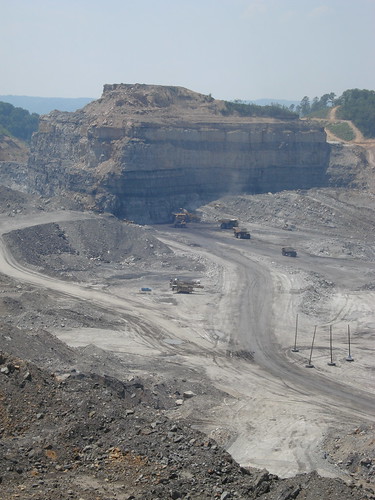
Desks and playground equipment, covered with a thin film of chemical-laden coal dust, sit just 225 feet from a coal silo. Overhead looms the Massey Energy Shumate impoundment, an embankment holding back 2.8 billion gallons of toxic liquid coal waste. Welcome to Marsh Fork Elementary School.
Ed Wiley’s granddaughter, Kayla, attended this school nestled in the Coal River Valley near Sundial, W.Va. Kayla inspired Wiley’s campaign, Pennies of Promise, to raise the $8.6 million needed to build the children a new school in a safe location.
Today, that mission is a success. Gov. Joe Manchin held a press conference on Friday to announce that Massey Energy and the Raleigh County School Board would supply the final $1.5 million needed to complete the necessary funding for a new school, matching a $2.5 million grant by the Annenberg Foundation announced on Thursday. Add this to the $10,400 raised by Pennies of Promise, $1 million from the Raleigh School Board, the $1 million promised by Massey energy, and the $2.6 million granted by the School Building Authority.
“The whole movement made this happen, the communities, all the kids collecting pennies across the country,” said local resident Judy Bonds. “This is a victory for everyone.”
Nearly five years ago, Kayla’s school called Wiley to come pick her up because she was ill. The trend continued for three successive days. On the third day, Wiley flipped through the school’s sign-out registry and noticed that several children were sent home each day. As they drove home that day, Kayla turned to Ed, tears in her eyes, and said, “Gramps, these coal mines are making us kids sick.” That moment changed everything for Wiley.
In 2006, Dr. Scott Simonton, the vice chair of West Virginia’s Environmental Quality Board, conducted an independent study at the school, sampling dust and particulate matter from various classrooms. Analysis of the data confirmed that the school’s environment was potentially unhealthy.
“My concern about the school is that dust levels not only appear to exceed human health reference levels, but that the dust is largely made up of coal,” said Dr. Simonton. “Coal dust contains silica, trace metals, and polynuclear aromatic hydrocarbons (PAH), many of which are known human carcinogens. Inhalation of coal dust is known to cause adverse health effects in humans, however, studies of coal dust toxicity are understandably mostly of adult populations. Children are particularly at risk from dust exposure in general, so it is reasonable to assume that coal dust creates an even greater risk for children than it does adult.”
The 380-foot-high dam that looms over the school, holding back an 8-acre lake of coal slurry, has been another long-standing concern. According to a report by the Office of Surface Mining and Reclamation, if the Shumate impoundment were to fail, a wall of sludge more than 20 feet high would tear down the valley below. The sludge would reach the community of Edwight a half-mile downstream within five minutes. Marsh Fork Elementary—located several hundred feet away from the base of the dam—would have far less.
The Shumate impoundment is listed by the state’s Department of Environmental Protection (WVDEP) as a Class C dam. According to the agency, these classes of impoundments “are those dams located where failure may cause a loss of human life or serious damage to homes, industrial and commercial buildings, important public utilities, primary highways or main haul roads.” Mine Safety and Health Administration officials have cited the dam for safety violations on multiple occasions.
For years, Wiley and other community members pleaded with local and state officials to build the Marsh Fork children a new, and safer, school. He founded the Pennies of Promise organization. According to Pennies of Promise, “In the absence of help from our elected officials, we have looked to each other for support as we are raising the funds necessary to build a new school in the community ourselves.”
Frustrated with the lack of support, in 2006, Wiley hoisted the Pennies of Promise flag and walked the 455 miles from Charleston, W.Va., to Washington D.C., to urge Sen. Robert C. Byrd to help. Senator Byrd met with Wiley and even issued a press statement, commending Wiley saying, “I admire the determination and dedication that Ed and Debbie Wiley have shown, the Bible teaches that if we have faith of a mustard seed, we can move mountains. I believe that the Wileys have that faith.” But ulitmately, Sen Byrd did not take action.
Wiley and and the community pressed on in their efforts to raise funding for the new school, reaching out to other schools and continuing to push the issue with their local, state and federal government officials. Wiley even reached out to other schools, such as the Washington Heights Expeditionary Learning School (WHEELS) in New York, who joined the fight and started their own penny jar for Marsh Fork Elementary.
And in 2010, their determination has finally made all the difference.
“There are a lot of people to thank,” Wiley said. “Nobody gave up. But the battle is not over, there a still a few schools just down the road here that are in jeopardy. We need to get a bill passed so you cannot have this kind of activity.”





 With this mornings
With this mornings 


 The Washington Post gave us a big sloppy pile of
The Washington Post gave us a big sloppy pile of 





BernardKuhajda.jpg)
